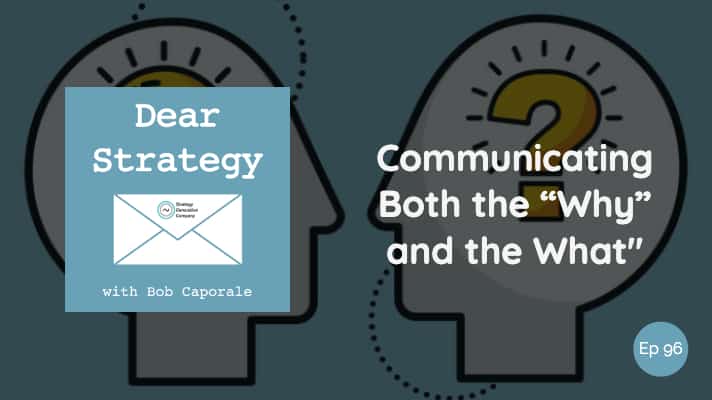Dear Strategy:
“How do you build a strategy that all levels of an organization can participate in and support – making sure to communicate the ‘why’ and not just the ‘what’?”
I absolutely love this question for many different reasons; not the least of which is that the answer is pretty much embedded within the question itself. In other words, most of the hard work on my end has already been done! But let’s see if I can’t add just a little bit more color around this very important piece of the strategy building process. And I’m going to do that in 3 parts, starting with…
Understanding The “Why”
To build a strategy that all levels of an organization can participate in, probably the most important thing you can do is to make sure that people understand why you’re building it in the first place. I liken this to a military analogy, which, of course, is the foundation upon which the entire field of business strategy is built.
If you are a general getting ready to lead your troops into battle (or stand right behind them, as the case may be), do you think it’s going to be important to let people know what they’re fighting for? We could hardly think about a successful military campaign being waged without rallying the troops behind a common cause or against a common enemy. Without that critical bit of mind swaying, it would be difficult to imagine that anyone would actually be motivated enough to follow your lead, let alone win a war.
Using that same logic, why would we think that any business strategy could possibly be successful if the people executing that strategy don’t have any idea of what it’s about? And, yet, that’s exactly the scenario that is faced by many businesses almost every single day.
“Why would we think that any business strategy could possibly be successful if the people executing that strategy don’t have any idea of what it’s about?”
The good news is, if you follow the strategy process that we teach here on this blog and through our Strategy Generation Framework, the “why” shows up as an integral part of your plan in the form of both your vision and your goals. But just because something is built into your strategy, that doesn’t mean people are actually going to know that it’s there. Which brings me to the second part of my answer, which is all about…
Communicating Your Strategy
This is a topic that we’ve, no doubt, covered many times before in this blog, but one part of the endless communication conundrum that we may not have fully addressed before has to do with exactly how a strategy is communicated down through a company’s usual chain of command.
Going back to our previous analogy, most every military organization has a very clear structure with very clear roles, responsibilities, and expectations placed upon each and every officer and each and every soldier based almost exclusively on their rank. In other words, there is usually no question as to how information is expected to flow through the organization, from the general, to the officers, all the way down to the soldiers fighting on the ground.
If we translate this into a corporate environment, somehow that chain of command doesn’t always seem to work quite as well – particularly as it relates to the topic of communicating strategies.
The reason for this (contrary to popular belief) generally doesn’t have to do with CEOs consciously wanting to withhold their strategies from the world. In fact, most CEOs that I have experience with seem to do a pretty good job of trying to socialize their respective company strategies wherever and whenever they can. Still, there is no denying that, if you ask a hundred employees to recite what their company strategies are, chances are, only a small handful of people will have even the slightest idea of how to respond. I know this isn’t particularly scientific, but I ask this question in almost every strategy workshop that I deliver and, inevitably, I never get more than 2 people out of a class of 25 who are willing to harbor a guess at what their company’s strategies might be.
So, what’s going wrong here?
In my observation, I find that the root cause of this little communication problem has to do with company executives not making it crystal clear to their next line of “officers” that it is their absolute collective job and responsibility to communicate the company strategy down through the ranks and out onto the front lines. Without any clear direction to the contrary, executives and their respective mid-level managers are likely to believe that their company’s strategies are confidential or, worse yet, that there are parts of those strategies that they’re not allowed to share. So, they share nothing. And the disease goes merrily on.
The cure is simple, and one that I make it a mission through my company to try and rectify. That is, when developing your strategy, make it crystal clear as to who is supposed to communicate what to whom, and give them all the tools to do just that. One way to do this is to create a “manager’s deck” – similar to a facilitator’s guide in the training world. This is the deck that every manager has permission to share. And, more than that, they are given complete instructions on exactly how to share it, along with a clear directive that they must share it as an integral part of their management responsibilities. Now it becomes a required part of their job. And, just like that, the problem is solved.
Obtaining Buy-In
There’s one more element to creating a strategy that everyone can participate in, and that is to actually ask them to participate in it during the strategy development process. I’ll keep this one short and simple, because it really is as short and simple as it sounds: If you want someone to support your plan, there’s no better way to do that than to have them help you create it. Or, at the very least, make sure their feedback is somehow reflected in your strategy, and that they know exactly what role that feedback played in its creation. More on that in a future blog, but I didn’t want to leave this topic without at least giving that third piece of the puzzle a quick shout-out.
So that’s my expansion on the question with the answer already built in. And if you follow these three simple pieces of advice, your strategy should be far better understood, far better socialized, and, hopefully, far better off for it.
Listen to the podcast episode
Dear Strategy: Episode 096

###
Are you interested in strategy workshops for your product, marketing, or business managers? If so, please be sure to visit Strategy Generation Company by clicking the link below:
 Bob Caporale is the founder of Strategy Generation Company, the author of Creative Strategy Generation and the host of the Dear Strategy podcast. You can learn more about his work by visiting bobcaporale.com.
Bob Caporale is the founder of Strategy Generation Company, the author of Creative Strategy Generation and the host of the Dear Strategy podcast. You can learn more about his work by visiting bobcaporale.com.






